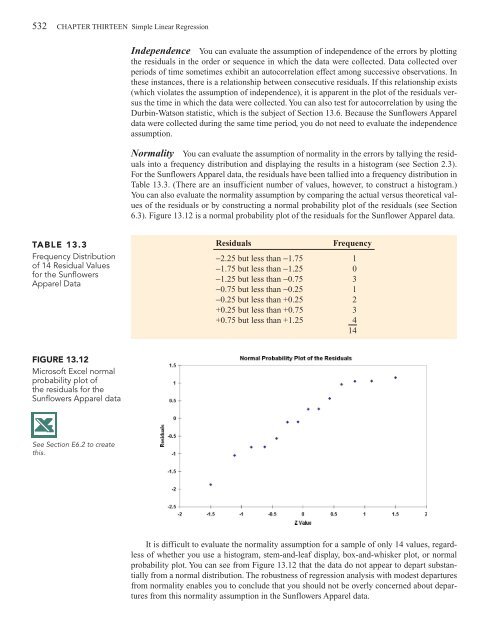CHAPTER 13 Simple Linear Regression
CHAPTER 13 Simple Linear Regression
CHAPTER 13 Simple Linear Regression
Create successful ePaper yourself
Turn your PDF publications into a flip-book with our unique Google optimized e-Paper software.
532 <strong>CHAPTER</strong> THIRTEEN <strong>Simple</strong> <strong>Linear</strong> <strong>Regression</strong><br />
Independence You can evaluate the assumption of independence of the errors by plotting<br />
the residuals in the order or sequence in which the data were collected. Data collected over<br />
periods of time sometimes exhibit an autocorrelation effect among successive observations. In<br />
these instances, there is a relationship between consecutive residuals. If this relationship exists<br />
(which violates the assumption of independence), it is apparent in the plot of the residuals versus<br />
the time in which the data were collected. You can also test for autocorrelation by using the<br />
Durbin-Watson statistic, which is the subject of Section <strong>13</strong>.6. Because the Sunflowers Apparel<br />
data were collected during the same time period, you do not need to evaluate the independence<br />
assumption.<br />
Normality You can evaluate the assumption of normality in the errors by tallying the residuals<br />
into a frequency distribution and displaying the results in a histogram (see Section 2.3).<br />
For the Sunflowers Apparel data, the residuals have been tallied into a frequency distribution in<br />
Table <strong>13</strong>.3. (There are an insufficient number of values, however, to construct a histogram.)<br />
You can also evaluate the normality assumption by comparing the actual versus theoretical values<br />
of the residuals or by constructing a normal probability plot of the residuals (see Section<br />
6.3). Figure <strong>13</strong>.12 is a normal probability plot of the residuals for the Sunflower Apparel data.<br />
TABLE <strong>13</strong>.3<br />
Frequency Distribution<br />
of 14 Residual Values<br />
for the Sunflowers<br />
Apparel Data<br />
Residuals<br />
Frequency<br />
−2.25 but less than −1.75 1<br />
−1.75 but less than −1.25 0<br />
−1.25 but less than −0.75 3<br />
−0.75 but less than −0.25 1<br />
−0.25 but less than +0.25 2<br />
+0.25 but less than +0.75 3<br />
+0.75 but less than +1.25 4<br />
14<br />
FIGURE <strong>13</strong>.12<br />
Microsoft Excel normal<br />
probability plot of<br />
the residuals for the<br />
Sunflowers Apparel data<br />
See Section E6.2 to create<br />
this.<br />
It is difficult to evaluate the normality assumption for a sample of only 14 values, regardless<br />
of whether you use a histogram, stem-and-leaf display, box-and-whisker plot, or normal<br />
probability plot. You can see from Figure <strong>13</strong>.12 that the data do not appear to depart substantially<br />
from a normal distribution. The robustness of regression analysis with modest departures<br />
from normality enables you to conclude that you should not be overly concerned about departures<br />
from this normality assumption in the Sunflowers Apparel data.

















